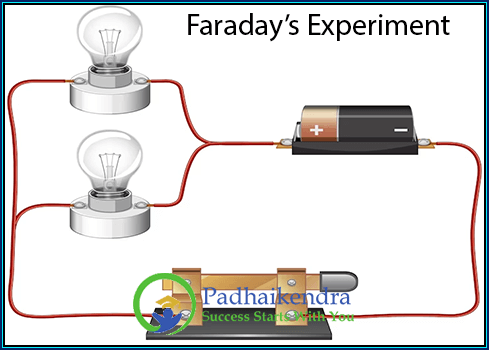Faraday’s experiment, also known as Faraday’s induction experiment, was a series of experiments performed by the British scientist Michael Faraday in 1831. The experiments demonstrated the relationship between a changing magnetic field and an induced electric current.
Faraday discovered that if a magnet is moved near a closed loop of wire, an electric current is induced in the wire. The amount of induced current depends on the strength of the magnet, the speed of the movement, and the number of turns in the wire.
 In his famous experiment, Faraday took a coil of wire and connected it to a galvanometer, which is an instrument that measures electric currents. He then moved a magnet toward the coil, causing the galvanometer to show a momentary deflection, indicating the presence of an induced electric current in the coil.
In his famous experiment, Faraday took a coil of wire and connected it to a galvanometer, which is an instrument that measures electric currents. He then moved a magnet toward the coil, causing the galvanometer to show a momentary deflection, indicating the presence of an induced electric current in the coil.
Faraday also discovered that the direction of the induced current depends on the direction of the movement of the magnet, as well as the orientation of the magnet with respect to the coil.
This experiment demonstrated that a changing magnetic field can produce an electric current, which led to the development of electric generators and motors. Faraday’s work on electromagnetic induction was a major breakthrough in the field of electromagnetism and had a significant impact on the development of modern technology.
Faraday’s experiment FAQs
Faraday's experiment refers to a series of groundbreaking experiments conducted by the physicist and chemist Michael Faraday in the 19th century. These experiments demonstrated the relationship between electricity and magnetism and led to the development of electromagnetic theory.
Faraday's experiments established that an electric current could be induced by changing magnetic fields and vice versa, demonstrating the principle of electromagnetic induction. He also discovered the laws of electrolysis, which relate the amount of chemical reactions occurring during electrolysis to the amount of electric charge passed through a solution.
Electromagnetic induction is the process by which an electric current is produced in a conductor when it is exposed to a changing magnetic field. This phenomenon forms the basis for the functioning of generators, transformers, and many electrical devices.
Faraday demonstrated electromagnetic induction by using a coil of wire and a magnet. When the magnet was moved relative to the coil, an electric current was induced in the wire. He also discovered that the magnitude of the induced current depended on the rate of change of the magnetic field.
Faraday's law of electromagnetic induction states that the magnitude of the electromotive force (emf) induced in a conductor is directly proportional to the rate of change of the magnetic field cutting through the conductor. This law forms the basis for understanding the generation of electric power.
Faraday's experiments laid the foundation for the development of electric power generation and distribution systems. His work on electromagnetic induction paved the way for the invention of the electric generator, which converts mechanical energy into electrical energy.
Yes, Faraday's experiments had significant practical applications. His discoveries in electromagnetic induction and electrolysis laid the groundwork for the development of numerous technologies, including electric motors, transformers, power generation, and electrochemical processes.
Faraday's experiments revolutionized our understanding of the relationship between electricity and magnetism. His work led to the formulation of Maxwell's equations, which unified the theories of electricity and magnetism and paved the way for the development of modern electromagnetic theory.
Faraday's experiments opened up new areas of research and played a crucial role in the development of the field of electromagnetism. They inspired subsequent generations of scientists and engineers to further explore the relationship between electricity and magnetism, leading to many significant technological advancements.
Faraday's contributions to science and his innovative experiments earned him the reputation as one of the greatest experimentalists in history. His discoveries and insights revolutionized our understanding of electromagnetism and laid the foundation for many modern technologies that shape our lives today.
 In his famous experiment, Faraday took a coil of wire and connected it to a galvanometer, which is an instrument that measures electric currents. He then moved a magnet toward the coil, causing the galvanometer to show a momentary deflection, indicating the presence of an induced electric current in the coil.
In his famous experiment, Faraday took a coil of wire and connected it to a galvanometer, which is an instrument that measures electric currents. He then moved a magnet toward the coil, causing the galvanometer to show a momentary deflection, indicating the presence of an induced electric current in the coil.




